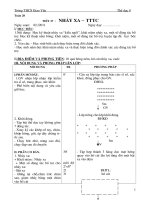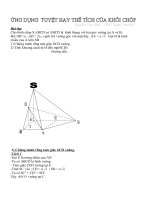Tài liệu The Botanical Magazine - Or, Flower Garden Displayed, Volume Viiii (illustrated Edition) By William Curtis ppt
Bạn đang xem bản rút gọn của tài liệu. Xem và tải ngay bản đầy đủ của tài liệu tại đây (8.16 MB, 111 trang )
The Botanical Magazine;
or, Flower-Garden
Displayed, Volume VIIII
William Curtis
THE
BOTANICAL MAGAZINE;
OR,
FLOWER-GARDEN DISPLAYED:
IN WHICH
The most Ornamental FOREIGN PLANTS, cultivated in the Open
Ground, the Green-House, and the Stove, are accurately represented
in their natural Colours.
TO WHICH ARE ADDED,
Their Names, Class, Order, Generic and Specific Characters,
according to the celebrated LINNỈUS; their Places of Growth, and
Times of Flowering:
TOGETHER WITH
THE MOST APPROVED METHODS OF CULTURE.
A WORK
Intended for the Use of such LADIES, GENTLEMEN, and GARDENERS, as
wish to become scientifically acquainted with the Plants they
cultivate.
By WILLIAM CURTIS,
Author of the FLORA LONDINENSIS.
VOL. VIII.
“Much I love
To see the fair one bind the straggling pink,
Cheer the sweet rose, the lupin, and the stock,
And lend a staff to the still gadding pea.
Ye fair, it well becomes you. Better thus
Cheat time away, than at the crowded rout,
Rustling in silk, in a small room, close-pent,
And heated e’en to fusion; made to breathe
A rank contagious air, and fret at whist,
Or sit aside to sneer and whisper scandal.”
Village Curate, p. 74.
M DCC XCIV.
CONTENTS
[253]—LATHYRUS ARTICULATUS. JOINTED-PODDED LATHYRUS.
[254]—LOPEZIA RACEMOSA. MEXICAN LOPEZIA.
[255]—CYTISUS SESSILIFOLIUS. SESSILE-LEAV’D, OR COMMON CYTISUS.
[256]—IXIA LONGIFLORA. LONG-FLOWER’D IXIA.
[257]—LYCHNIS CHALCEDONICA. SCARLET LYCHNIS.
[258]—CORONILLA VARIA. PURPLE CORONILLA.
[259]—LILIUM CATESBỈI. CATESBY’S LILY.
[260]—METROSIDEROS CITRINA. HARSH-LEAV’D METROSIDEROS.
[261]—ERODIUM INCARNATUM. FLESH-COLOURED CRANE’S-BILL.
[262]—MESEMBRYANTHEMUM AUREUM. GOLDEN FIG-MARIGOLD.
[263]—GLYCINE BIMACULATA. PURPLE GLYCINE.
[264]—CISTUS FORMOSUS. BEAUTIFUL CISTUS.
[265]—IXIA BULBOCODIUM. CROCUS-LEAV’D IXIA.
[266]—RANUNCULUS AMPLEXICAULIS. PLANTAIN-LEAVED CROWFOOT.
[267]—PYRUS SPECTABILIS. CHINESE APPLE TREE.
[268]—GLYCINE RUBICUNDA. DINGY-FLOWERED GLYCINE.
[269]—ORNITHOGALUM NUTANS. NEAPOLITAN STAR OF BETHLEHEM.
[270]—GLYCINE COCCINEA. SCARLET GLYCINE.
[271]—CYRTANTHUS ANGUSTIFOLIUS. NARROW-LEAVED CYRTANTHUS.
[272]—GLADIOLUS TRISTIS. SQUARE-LEAVED CORN-FLAG.
[273]—DIOSMA UNIFLORA. ONE-FLOWERED DIOSMA.
[274]—BORBONIA CRENATA. HEART-LEAVED BORBONIA.
[275]—LIRIODENDRON TULIPIFERA. COMMON TULIP-TREE.
[276]—BLITUM VIRGATUM. STRAWBERRY BLITE.
[277]—MAHERNIA PINNATA. WINGED MAHERNIA.
[278]—LILIUM CANDIDUM. WHITE LILY.
[279]—PLUMERIA RUBRA. RED PLUMERIA.
[280]—APOCYNUM ANDROSỈMIFOLIUM. TUTSAN-LEAV’D,
OR
FLY-
CATCHING DOGSBANE.
[281]—TURNERA ANGUSTIFOLIA. NARROW-LEAV’D TURNERA.
[282]—HEDYSARUM OBSCURUM. CREEPING-ROOTED HEDYSARUM.
[283]—MIMULUS RINGENS. NARROW-LEAVED MONKEY-FLOWER.
[284]—ROSA SEMPERFLORENS. EVER-BLOWING ROSE.
[285]—JASMINUM ODORATISSIMUM. SWEETEST JASMINE.
[286]—PORTLANDIA GRANDIFLORA. GREAT-FLOWERED PORTLANDIA.
[287]—GOODENIA LỈVIGATA. SMOOTH GOODENIA.
[288]—PASSIFLORA CILIATA. FRINGED-LEAVED PASSION-FLOWER.
The Botanical Magazine; or, Flower-Garden Displayed, Volume VIIII
[253]
LATHYRUS ARTICULATUS. JOINTED-PODDED LATHYRUS.
Class and Order.
DIADELPHIA DECANDRIA.
Generic Character.
Stylus planus, supra villosus, superne latior. Cal. laciniæ superiores
2-breviores.
Specific Character and Synonyms.
LATHYRUS articulatus pedunculis subunifloris, cirrhis polyphyllis;
foliolis alternis. Linn. Syst. Veg. ed. 14. Murr. p. 662. Ait. Kew. v. 2. p.
41.
CLYMENUM hispanicum, flore vario, siliqua articulata. Tourn. Inst.
396.
LATHYRUS hispanicus, pedunculis bifloris, cirrhis polyphyllis
foliolis alternis. Mill. Dict. ed. 6. 4to.
The seed-vessels are of the first importance in ascertaining the
several species of Lathyrus, some being naked, others hairy, some
long, others short, some having a smooth and perfectly even surface,
others, as in the present instance, assuming an uneven or jointed
appearance.
Of this genus we have already figured three annual species, common
in flower-gardens, viz. odoratus, tingitanus, and sativus; to these we
now add the articulatus, not altogether so frequently met with, but
meriting a place on the flower-border, as the lively red and delicate
white so conspicuous in its blossoms, causes it to be much admired.
It is a native of Italy, and was cultivated at the Chelsea Garden, in
the time of Mr. RAND, anno 1739.
1
The Botanical Magazine; or, Flower-Garden Displayed, Volume VIIII
No253.
2
The Botanical Magazine; or, Flower-Garden Displayed, Volume VIIII
It is a hardy annual, requiring support, and rarely exceeding the
height of two feet, flowering in July and August, and is readily
raised from seeds, which should be sown in the open border at the
beginning of April.
3
The Botanical Magazine; or, Flower-Garden Displayed, Volume VIIII
[254]
LOPEZIA RACEMOSA. MEXICAN LOPEZIA.
Class and Order.
MONANDRIA MONOGYNIA.
Generic Character.
Cal. 4-phyllus. Cor. irregularis, pentapetala, duo superiora
geniculata, quintum inferne declinatum, plicatum, ungue arcuata.
Specific Character and Synonyms.
LOPEZIA racemosa caule herbaceo ramoso; foliis alternis ovatolanceolatis, serratis; floribus racemosis. Cavanilles Ic. et descr. Pl.
Some plants have a claim on our attention for their utility, some for
their beauty, and some for the singularity of their structure, and the
wonderful nature of their œconomy; in the last class we must place
the present plant, the flowers of which we recommend to the
examination of such of our readers as may have an opportunity of
seeing them; to the philosophic mind, not captivated with mere
shew, they will afford a most delicious treat.
We first saw this novelty in flower, towards the close of the year
1792, at the Apothecaries Garden, Chelsea, where Mr. FAIRBAIRN
informed me, that he had that season raised several plants of it from
seeds, communicated by Dr. J. E. SMITH, who received them from
Madrid, to which place they were sent from South-America, and
where the plant as Mons. CAVANILLE informs us, grows
spontaneously near Mexico. In October 1793, we had the pleasure of
seeing the plant again in blossom in the aforesaid garden, raised
from seeds which ripened there the preceding year, but
unfortunately from the lateness of their flowering, and the very great
injury the plants had sustained from the Cobweb Mite (Acarus
teliarius) vulgarly called the red Spider, there seemed little prospect
that the seed-vessels would arrive at perfection.
4
The Botanical Magazine; or, Flower-Garden Displayed, Volume VIIII
No254.
5
The Botanical Magazine; or, Flower-Garden Displayed, Volume VIIII
The seeds were sown by Mr. FAIRBAIRN, in March, and the plants
kept in the green-house till very late in the summer, when to
accelerate their blowing, they were removed into the dry stove: it is
worthy of remark, that these plants, even late in the autumn, shew
no signs of blossoming, but the flowers at length come forth with
almost unexampled rapidity, and the seed-vessels are formed as
quickly, so that if the flowers were not very numerous, their
blossoming period would be of very short duration; future
experience may perhaps point out the means of making the plant
blow earlier: in Spain, the blossoms appeared later than here, Mons.
CAVANILLE observed them in the Royal Garden, in November and
December, most probably in the open ground, as no mention is made
of the plants having been preserved from the weather.
It was not till long after our description was taken, that we had an
opportunity of seeing Mons. CAVANILLE’S most accurate and elegant
work, above quoted, in which this plant is first figured and
described; we have selected the most essential parts of his generic
character, and adopted his specific description: there is one point,
however, in which we differ from him; the part which he regards as
the fifth Petal, we are inclined to consider rather as that indescribable
something, called by LINNỈUS the Nectary, it is indeed of little
moment whether we call it a Petal or a Nectary, but there are several
reasons why, strictly speaking, we cannot regard it as a Petal: in
general the number of Petals correspond with the number of the
leaves of the Calyx, those of the latter are four; the base of this
Nectary originates deeper than the claws of the Petals, springing in
fact from the same part as the Filament, its structure, especially the
lower part of it, is evidently different from that of the Petals,
corresponding indeed as nearly as possible with that of the base of
the filament.—Vid. DESCER.
Mons. CAVANILLE was induced to call this plant Lopezia, in
compliment to TH. LOPEZ, a Spaniard[1].
6
The Botanical Magazine; or, Flower-Garden Displayed, Volume VIIII
DESCRIPTION OF THE LOPEZIA.
ROOT annual.
STALK five or six feet high, branched almost to the bottom, square,
of a deep red colour, smooth towards the bottom, slightly hairy
above: Branches like the stalk.
LEAVES alternate, ovate, pointed, toothed on the edges, more so on
the larger leaves, slightly beset with soft hairs, veins prominent on
the under side, usually running parallel to each other and
unbranched: Leafstalks hairy.
FLOWERS numerous, from the alæ of the leaves, growing
irregularly on hairy leafy racemi, standing on long slender
peduncles, which hang down as the seed-vessels are produced: in
this and some others of its characters, the plant shews some affinity
to the Circæa.
CALYX: a Perianthium of four leaves, sitting on the Germen, leaves
narrow, concave, reddish, with green tips, the lowermost one widely
separated from the others, and placed immediately under the
Nectary, fig. 1.
COROLLA four Petals of a pale red colour, forming in their mode of
growth the upper half of a circle, the two uppermost linear, of a
deeper colour near the apex, jointed below the middle, with a small
green gland on each joint, standing on short round footstalks, which
are hairy when magnified, the two side Petals nearly orbicular with
long narrow claws, the part between the base of the Petal and the
claw of a deeper red or crimson, fig. 2.
NECTARY situated below the Petals, perfectly white, somewhat
ovate, the sides folding together, before the flower fully expands,
nearly upright, embracing and containing within it the Pistillum and
Stamen, on touching it ever so slightly with the point of a pin, while
in this state, it suddenly springs back and quits the Pistillum, the
lower elastic part of it is then bent in the form represented in a
magnified view of the flower on the plate, fig. 4. this curious
phœnomenon has not been noticed by CAVANILLE.
7
The Botanical Magazine; or, Flower-Garden Displayed, Volume VIIII
STAMEN: Filament one, tapering and very slender just below the
Anthera, arising from the same part as (and placed opposite to the
base of) the Nectary the lower part of it broader, somewhat fleshy,
cartilaginous, and of the same nature as the inferior part of the
Nectary, with a groove as that has on the inside, so that before the
flower expands, the bases of each are like two half tubes, the sides of
which, nearly touching each other, wholly enclose the Pistillum; as
the fructification goes forward, the Filament, endowed also with an
elastic power, bends back soon after the flower is open, betwixt the
two uppermost Petals, and becomes invisible to an inattentive
observer; the Anthera, which is large, is at first yellow, and
afterwards dark brown, fig. 5.
PISTILLUM: Germen below the Calyx, round, smooth, and green;
Style filiform, white, length of the Filament; Stigma forming a small
villous head, fig. 6. in some of the flowers the Pistillum appears
imperfect, being much shorter than usual, and wanting the Stigma,
perhaps such have not acquired their full growth, fig. 6.
PERICARPIUM (from CAVANILLE) a round Capsule, of four cells, and
four valves, the cells many-seeded.
SEEDS very minute, ovate, affixed to a four-cornered receptacle.
8
The Botanical Magazine; or, Flower-Garden Displayed, Volume VIIII
[255]
CYTISUS SESSILIFOLIUS. SESSILE-LEAV’D, OR COMMON CYTISUS.
Class and Order.
DIADELPHIA DECANDRIA.
Generic Character.
Cal. 2-labiatus: 2/3 Legumen basi attenuatum.
Specific Character and Synonyms.
CYTISUS sessilifolius racemis erectis, calycibus bractæa triplici, foliis
floralibus sessilibus. Linn. Syst. Vegetab. ed. 14. Murr. p. 666. Ait. Kew.
v. 2. p. 50.
CYTISUS glabris foliis subrotundis, pediculis brevissimis. Bauh. Pin.
p. 390.
CYTISUS vulgatior, the common Tree Trefoile. Park. Parad. p. 440.
The term sessilifolius has been given to this species of Cytisus,
because the leaves are for the most part sessile, that is sit close to the
branches, without any or very short footstalks; such they are at least
on the flowering branches when the shrub is in blossom, but at the
close of the summer they are no longer so, the leaves acquiring very
evident footstalks.
It is a native of the more southern parts of Europe, and though in
point of size and elegance it cannot vie with its kindred Laburnum, it
is a deciduous shrub of considerable beauty, rarely exceeding the
height of five or six feet, and producing a great profusion of bright
yellow flowers, which continue in blossom a long while; they make
their appearance in May and June, and are usually succeeded by
seed-vessels which produce ripe seeds, by these the plant is readily
propagated.
9
The Botanical Magazine; or, Flower-Garden Displayed, Volume VIIII
No255.
10
The Botanical Magazine; or, Flower-Garden Displayed, Volume VIIII
It is one of the most common shrubs we have, as well as one of the
oldest inhabitants of our shrubberies, being mentioned by
PARKINSON in his Parad. Terrestris.
11
The Botanical Magazine; or, Flower-Garden Displayed, Volume VIIII
[256]
IXIA LONGIFLORA. LONG-FLOWER’D IXIA.
Class and Order.
TRIANDRIA MONOGYNIA.
Generic Character.
Cor. 6-partita, campanulata, regularis. Stigmata 3.
Specific Character and Synonyms.
IXIA longiflora foliis ensiformibus linearibus strictis, tubo filiformi
longissimo. Ait. Kew. v. 4. p. 58.
GLADIOLUS longiflorus caule tereti, tubo longissimo, spathis
foliisque linearibus glabris. Linn. Suppl. p. 96. Gmel. Syst. Vegetab. ed.
14. Murr. p. 86.
We are not acquainted with a tribe of plants which stand more in
need of elucidation than those of this genus; of the vast numbers
imported from the Cape within these few years, where they are
chiefly natives, and that for the most part by way of Holland, few
comparatively are well ascertained; some of them appear subject to
great variation, both in the size and colour of their blossoms
(whether in their wild state they are thus inconstant, or whether
there are seminal varieties raised by the persevering industry of the
Dutch Florists, we have not yet had it in our power satisfactorily to
ascertain); others like the present one have their characters strongly
marked, and less variable; in general they are plants of easy culture,
requiring chiefly to be protected from the effects of frost, the least
degree of which is presently fatal to most of them.
The treatment recommended for the Ixia flexuosa is applicable to this
and the other Cape species.
12
The Botanical Magazine; or, Flower-Garden Displayed, Volume VIIII
No256.
13
The Botanical Magazine; or, Flower-Garden Displayed, Volume VIIII
According to the Hort. Kew. this species was introduced by Mr.
MASSON in the year 1774.
It flowers from April to June.
14
The Botanical Magazine; or, Flower-Garden Displayed, Volume VIIII
[257]
LYCHNIS CHALCEDONICA. SCARLET LYCHNIS.
Class and Order.
DECANDRIA PENTAGYNIA.
Generic Character.
Cal. 1-phyllus, oblongus, lævis. Petala 5-unguiculata. Limbo subbifido. Caps. 5-locularis.
Specific Character and Synonyms.
LYCHNIS chalcedonica floribus fasciculatis fastigiatis. Linn. Syst.
Vegetab. ed. 14. Murr. p. 435. Ait. Kew. v. 2. p. 16.
LYCHNIS hirsuta flore coccineo major. Bauh. Pin. 203.
FLOS Constantinopolitanus. Dod. Pempt. 178.
LYCHNIS chalcedonica flore simplici miniato. Single Nonsuch, or
Flower of Bristow or Constantinople. Parkins. Parad. 253.
The Scarlet Lychnis appears to have been a great favourite with
PARKINSON, he calls it a glorious flower, and in a wooden print of
him prefixed to his Paradisus Terrestris, we see him represented with
a flower of this sort in his hand of the double kind.
It grows spontaneously in most parts of Russia, and is one of our
most hardy perennials.
The extreme brilliancy of its flowers renders it a plant, in its single
state highly ornamental; when double, its beauty is heightened, and
the duration of it increased.
It flowers in June and July.
15
The Botanical Magazine; or, Flower-Garden Displayed, Volume VIIII
No257.
16
The Botanical Magazine; or, Flower-Garden Displayed, Volume VIIII
The single sort may be increased by parting its roots in autumn, but
more abundantly by seeds, which should be sown in the spring; the
double sort may also be increased by dividing its roots, but more
plentifully by cuttings of the stalk, put in in June, before the flowers
make their appearance; in striking of these, however, there requires
some nicety.
This plant is found to succeed best in a rich, loamy, soil; and certain
districts have been found to be more favourable to its growth than
others.
A white and a pale red variety of it in its single state were known to
CLUSIUS, and similar varieties of the double kind are said to exist; it
is of little moment whether they do or not, every variation in this
plant from a bright scarlet is in every sense of the word a
degeneracy.
17









